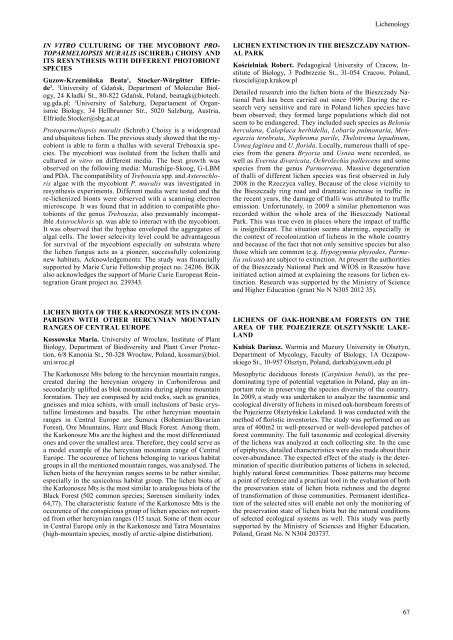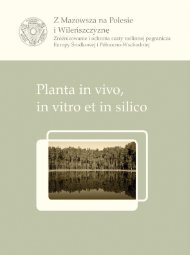acta societatis botanicorum poloniae - LV Zjazd Polskiego ...
acta societatis botanicorum poloniae - LV Zjazd Polskiego ...
acta societatis botanicorum poloniae - LV Zjazd Polskiego ...
You also want an ePaper? Increase the reach of your titles
YUMPU automatically turns print PDFs into web optimized ePapers that Google loves.
in vitro CULTUrING OF THE MYCOBIONT ProtoPArmelioPsis<br />
murAlis (SCHrEB.) CHOISY ANd<br />
ITS rESYNTHESIS WITH dIFFErENT PHOTOBIONT<br />
SPECIES<br />
Guzow-Krzemińska Beata1 , Stocker-Wörgötter Elfriede2<br />
. 1University of Gdańsk, Department of Molecular Biology,<br />
24 Kładki St., 80-822 Gdańsk, Poland, beatagk@biotech.<br />
ug.gda.pl; 2University of Salzburg, Departament of Organismic<br />
Biology, 34 Hellbrunner Str., 5020 Salzburg, Austria,<br />
Elfriede.Stocker@sbg.ac.at<br />
Protoparmeliopsis muralis (Schreb.) Choisy is a widespread<br />
and ubiquitous lichen. The previous study showed that the mycobiont<br />
is able to form a thallus with several Trebouxia species.<br />
The mycobiont was isolated from the lichen thalli and<br />
cultured in vitro on different media. The best growth was<br />
observed on the following media: Murashige-Skoog, G-LBM<br />
and PDA. The compatibility of Trebouxia spp. and Asterochloris<br />
algae with the mycobiont P. muralis was investigated in<br />
resynthesis experiments. Different media were tested and the<br />
re-lichenized bionts were observed with a scanning electron<br />
microscope. It was found that in addition to compatible photobionts<br />
of the genus Trebouxia, also presumably incompatible<br />
Asterochloris sp. was able to interact with the mycobiont.<br />
It was observed that the hyphae enveloped the aggregates of<br />
algal cells. The lower selecivity level could be advantageous<br />
for survival of the mycobiont especially on substrata where<br />
the lichen fungus acts as a pioneer, successfully colonizing<br />
new habitats. Acknowledgements: The study was financially<br />
supported by Marie Curie Fellowship project no. 24206. BGK<br />
also acknowledges the support of Marie Curie European Reintegration<br />
Grant project no. 239343.<br />
LICHEN BIOTA OF THE KArKONOSZE MTS IN COM-<br />
PArISON WITH OTHEr HErCYNIAN MOUNTAIN<br />
rANGES OF CENTrAL EUrOPE<br />
Kossowska Maria. University of Wrocław, Institute of Plant<br />
Biology, Department of Biodiversity and Plant Cover Protection,<br />
6/8 Kanonia St., 50-328 Wrocław, Poland, kossmar@biol.<br />
uni.wroc.pl<br />
The Karkonosze Mts belong to the hercynian mountain ranges,<br />
created during the hercynian orogeny in Carboniferous and<br />
secondarily uplifted as blok mountains during alpine mountain<br />
formation. They are composed by acid rocks, such as granites,<br />
gneisses and mica schists, with small inclusions of basic crystalline<br />
limestones and basalts. The other hercynian mountain<br />
ranges in Central Europe are Šumava (Bohemian/Bavarian<br />
Forest), Ore Mountains, Harz and Black Forest. Among them,<br />
the Karkonosze Mts are the highest and the most differentiated<br />
ones and cover the smallest area. Therefore, they could serve as<br />
a model example of the hercynian mountain range of Central<br />
Europe. The occurence of lichens belonging to various habitat<br />
groups in all the mentioned mountain ranges, was analysed. The<br />
lichen biota of the hercynian ranges seems to be rather similar,<br />
especially in the saxicolous habitat group. The lichen biota of<br />
the Karkonosze Mts is the most similar to analogous biota of the<br />
Black Forest (502 common species; Sørensen similarity index<br />
64,77). The characteristic feature of the Karkonosze Mts is the<br />
occurence of the conspicious group of lichen species not reported<br />
from other hercynian ranges (115 taxa). Some of them occur<br />
in Central Europe only in the Karkonosze and Tatra Mountains<br />
(high-mountain species, mostly of arctic-alpine distirbution).<br />
Lichenology<br />
LICHEN ExTINCTION IN THE BIESZCZAdY NATION-<br />
AL PArK<br />
Kościelniak Robert. Pedagogical University of Cracow, Institute<br />
of Biology, 3 Podbrzezie St., 31-054 Cracow, Poland,<br />
rkosciel@up.krakow.pl<br />
Detailed research into the lichen biota of the Bieszczady National<br />
Park has been carried out since 1999. During the research<br />
very sensitive and rare in Poland lichen species have<br />
been observed; they formed large populations which did not<br />
seem to be endangered. They included such species as Belonia<br />
herculana, Caloplaca herbidella, Lobaria pulmonaria, Menegazzia<br />
terebrata, Nephroma parile, Thelotrema lepadinum,<br />
Usnea faginea and U. florida. Locally, numerous thalli of species<br />
from the genera Bryoria and Usnea were recorded, as<br />
well as Evernia divaricata, Ochrolechia pallescens and some<br />
species from the genus Parmotrema. Massive degeneration<br />
of thalli of different lichen species was first observed in July<br />
2008 in the Rzeczyca valley. Because of the close vicinity to<br />
the Bieszczady ring road and dramatic increase in traffic in<br />
the recent years, the damage of thalli was attributed to traffic<br />
emission. Unfortunately, in 2009 a similar phenomenon was<br />
recorded within the whole area of the Bieszczady National<br />
Park. This was true even in places where the impact of traffic<br />
is insignificant. The situation seems alarming, especially in<br />
the context of recolonization of lichens in the whole country<br />
and because of the fact that not only sensitive species but also<br />
those which are common (e.g. Hypogymnia physodes, Parmelia<br />
sulcata) are subject to extinction. At present the authorities<br />
of the Bieszczady National Park and WIOŚ in Rzeszów have<br />
initiated action aimed at explaining the reasons for lichen extinction.<br />
Research was supported by the Ministry of Science<br />
and Higher Education (grant No N N305 2012 35).<br />
LICHENS OF OAK-HOrNBEAM FOrESTS ON THE<br />
AREA of tHE PoJEZIERZE oLSZtyńSKIE LAKE-<br />
LANd<br />
Kubiak dariusz. Warmia and Mazury University in Olsztyn,<br />
Department of Mycology, Faculty of Biology, 1A Oczapowskiego<br />
St., 10-957 Olsztyn, Poland, darkub@uwm.edu.pl<br />
Mesophytic deciduous forests (Carpinion betuli), as the predominating<br />
type of potential vegetation in Poland, play an important<br />
role in preserving the species diversity of the country.<br />
In 2009, a study was undertaken to analyze the taxonomic and<br />
ecological diversity of lichens in mixed oak-hornbeam forests of<br />
the Pojezierze Olsztyńskie Lakeland. It was conducted with the<br />
method of floristic inventories. The study was performed on an<br />
area of 400m2 in well-preserved or well-developed patches of<br />
forest community. The full taxonomic and ecological diversity<br />
of the lichens was analyzed at each collecting site. In the case<br />
of epiphytes, detailed characteristics were also made about their<br />
cover-abundance. The expected effect of the study is the determination<br />
of specific distribution patterns of lichens in selected,<br />
highly natural forest communities. Those patterns may become<br />
a point of reference and a practical tool in the evaluation of both<br />
the preservation state of lichen biota richness and the degree<br />
of transformation of those communities. Permanent identification<br />
of the selected sites will enable not only the monitoring of<br />
the preservation state of lichen biota but the natural conditions<br />
of selected ecological systems as well. This study was partly<br />
supported by the Ministry of Sciences and Higher Education,<br />
Poland, Grant No. N N304 203737.<br />
67



